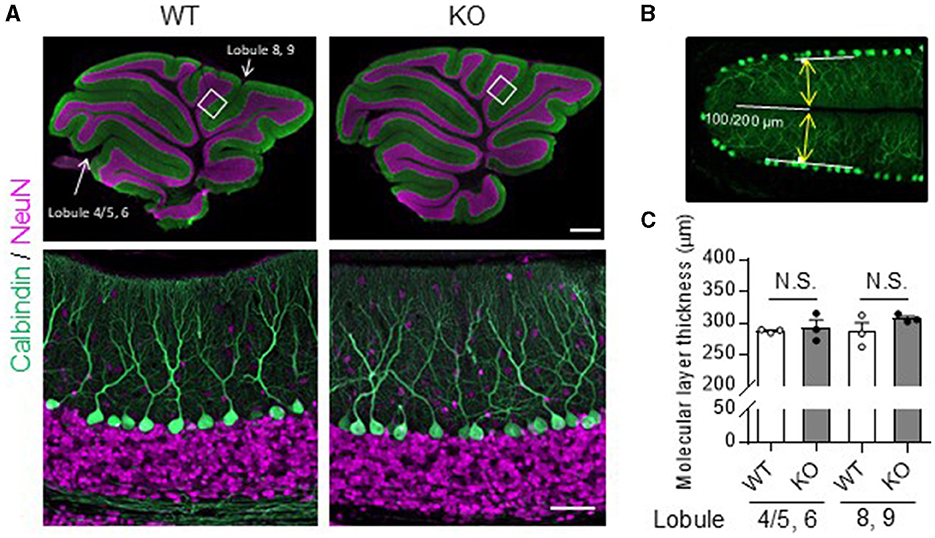- 1Department of Neurophysiology and Neural Repair, Gunma University Graduate School of Medicine, Maebashi, Japan
- 2Department of Medicine and Molecular Science, Gunma University Graduate School of Medicine, Maebashi, Japan
- 3Research Program for Neural Signalling, Division of Endocrinology, Metabolism and Signal Research, Gunma University Initiative for Advanced Research, Maebashi, Japan
A corrigendum on
Contribution of thyrotropin-releasing hormone to cerebellar long-term depression and motor learning
by Watanave, M., Matsuzaki, Y., Nakajima, Y., Ozawa, A., Yamada, M., and Hirai, H. (2018). Front. Cell. Neurosci. 12:490. doi: 10.3389/fncel.2018.00490
In the published article, there was an error in Figure 1 as published. The captions “lobule 4/5,6” and “lobule 8,9” in the upper left panel of Figure 1A are reversed. The corrected Figure 1 appears below.

Figure 1. No obvious morphological differences in the cerebellum were found between TRH-KO mice and their WT littermates. Immunohistochemistry was used to compare sagittal cerebellar sections from TRH-KO mice to those from their WT littermates. Slices were double-immunostained for calbindin, a marker of PCs (green), and NeuN, a marker of granule cells (magenta). (A) Sagittal sections of the WT (left) and TRH-KO (right) cerebellum. The boxed areas in upper panels are enlarged. Scale bar: 500 μm (upper right) and 50 μm (lower right). KO, knock-out; WT, wild-type. (B, C) Quantitative analysis of the molecular layer thickness. The molecular layer thickness was measured at two different points on the sagittal section of the cerebellar vermis: lobule 4/5 and lobule 6 at 100 μm from the end of the primary fissure, and lobule 8 and lobule 9 at 200 μm from the end of the secondary fissure (B). The molecular layer thickness of both sides of the fissure was measured, and the sum was defined as molecular layer thickness. There are no significant differences at both two points between genotypes (C). KO, knock-out; N.S., not significant; WT, wild-type.
The authors apologize for this error and state that this does not change the scientific conclusions of the article in any way. The original article has been updated.
Publisher's note
All claims expressed in this article are solely those of the authors and do not necessarily represent those of their affiliated organizations, or those of the publisher, the editors and the reviewers. Any product that may be evaluated in this article, or claim that may be made by its manufacturer, is not guaranteed or endorsed by the publisher.
Keywords: thyrotropin-releasing hormone, motor learning, cerebellum, LTD, NO
Citation: Watanave M, Matsuzaki Y, Nakajima Y, Ozawa A, Yamada M and Hirai H (2024) Corrigendum: Contribution of thyrotropin-releasing hormone to cerebellar long-term depression and motor learning. Front. Cell. Neurosci. 18:1495155. doi: 10.3389/fncel.2024.1495155
Received: 12 September 2024; Accepted: 16 September 2024;
Published: 26 September 2024.
Approved by:
Frontiers Editorial Office, Frontiers Media SA, SwitzerlandCopyright © 2024 Watanave, Matsuzaki, Nakajima, Ozawa, Yamada and Hirai. This is an open-access article distributed under the terms of the Creative Commons Attribution License (CC BY). The use, distribution or reproduction in other forums is permitted, provided the original author(s) and the copyright owner(s) are credited and that the original publication in this journal is cited, in accordance with accepted academic practice. No use, distribution or reproduction is permitted which does not comply with these terms.
*Correspondence: Hirokazu Hirai, aGlyYWlAZ3VubWEtdS5hYy5qcA==
 Masashi Watanave
Masashi Watanave Yasunori Matsuzaki1
Yasunori Matsuzaki1 Hirokazu Hirai
Hirokazu Hirai